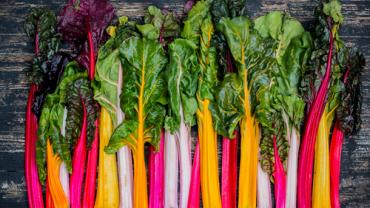
Looking to add more greens to your diet but afraid you’ll completely shut down if you see one more kale chip or spinach salad? Consider chard! Available year-round and in an array of eye-catching colors, chard is a nutritious and hardy green that pops up a lot in rustic Italian cooking, but graces North American tables far less frequently. Not to worry; there are plenty of ways to incorporate chard into your cooking and expand your culinary repertoire.
If chard stalks and leaves remind you of beet greens, with their bold red stalks and red veins running through the leaves, it won’t surprise you to learn they’re considered the same species (Beta vulgaris), but different sub-species. (No need to worry about pink urine from eating chard, though!) Chard comes in the same bright red color as beets, but you may also see stalks and ribs that are yellow, pink, or white. Chard is also known as silverbeet or mangold. The word “chard” comes from the French carde and the Latin carduus, meaning artichoke thistle or cardoon, including the artichoke. It’s less clear where the “Swiss” part originated, since this plant is native to the Mediterranean, not Switzerland. (It may have first been formally described by a Swiss botanist.)
Like other greens, chard is rich in vitamin K1 and folate, and it’s also a good source of vitamin C, magnesium, potassium, and manganese. It’s high in fiber, and its calorie content is almost negligible—just 19 calories for around 3.5 ounces. (Not surprising, considering they’re about 93 percent water!) Some of the minerals may be lost to the cooking water when chard is boiled, which is unfortunate, because boiling is an often-recommended cooking method for chard. This is due to chard’s high oxalate content, as some of the oxalic acid may be reduced when the vegetable is boiled. Chard is typically included on lists of high oxalate foods, particularly for individuals with recurrent kidney stones. While some individuals may need to limit their intake of these foods, a reasonable amount of chard is fine for most people. (Some people confuse chard and rhubarb, as their red stalks do look similar. Rhubarb leaves are far higher in oxalate than chard’s are.)
Chard can be very bitter, so it is sometimes paired with sweeter ingredients to help take some of the edge off. Raisins are a classic pairing with chard, such as in Swiss chard and golden raisins, or Spanish-style Swiss chard with raisins and pine nuts. Chard is often paired with nuts, such as rainbow chard with hazelnuts, and Swiss chard salad with toasted walnuts. For anyone looking to change up their creamed spinach, how about creamy chard? Like any leafy green, chard is great for low-carb, Paleo, vegetarian, and vegan diets. It pairs well with green herbs (like in these Swiss chard fritters), and is a great accompaniment to meat or poultry, like in rainbow chard and chicken stir-fry.
The attractive colors of chard are more than just pleasing to the eye. The different colored cultivars contain different types of betalains—phytochemicals that may help support phase II detoxification (reddish-purple betacyanin pigments in the red chard and yellow betaxanthin in the yellow). Like many other vegetables, chard is rich in antioxidants. The antioxidant activity and variety of phenolic compounds differs between the leaves and the stems, which is a good reason to eat both. The leaves are typically sautéed, and the stems can be cooked the same way, but don’t be surprised if you ever see both parts on a pizza! (Use a gluten-free crust if you prefer.)
Sources